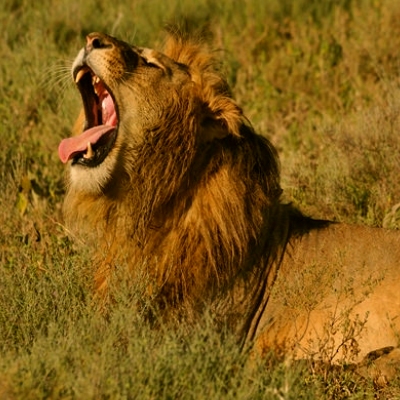THE SERENGETI WILDEBEEST MIGRATION
The Serengeti wildebeest migration is Africa’s great migration and happens every year where by large numbers of wildebeests(over 2 million) and other animals like the grant’s gazelles, impalas, zebras(over 200,000), elands, and Thomson’s gazelles migrate from the Serengeti plains in Tanzania to the Masai Mara in Kenya. They move clockwise over 1,800 miles annually which makes their migration easy to predict. They mainly migrate in search for better water quality and new grazing grasslands. The annual migration safari of over a million wildebeest occurs every year in 2 prominent parks, Kenya’s Masai Mara National Park and Tanzania’s Serengeti National Park.
Animals in the Great Wildebeest Migration
The wildebeest migration is one of the most amazing events one should never miss out, nothing is thrilling like watching the these animals in big numbers running up and down in the grasslands and crossing rivers, it gives an unforgettable experience in the wild.
Below are the animals that take part in this migration:
Wildebeests
Wildebeests are mammals and belong to the antelope family, and it is estimated that there are about one and a half million (1.5 million) wildebeests that take part in this migration. They are classified into different species of which all of them are native to Africa; they include the Western-bearded wildebeest these are the ones that migrate within the Serengeti and Masai Mara, the Eastern white-bearded wildebeests found in Tanzania and Kenya in the East of Gregory rift and the Blue or brindled wildebeests found in the south of River Zambezi. The other name to refer to wildebeest is “Gnu”; they are herbivorous animals and basically live in the open woodlands and savannah grasslands which is where they get what to eat.
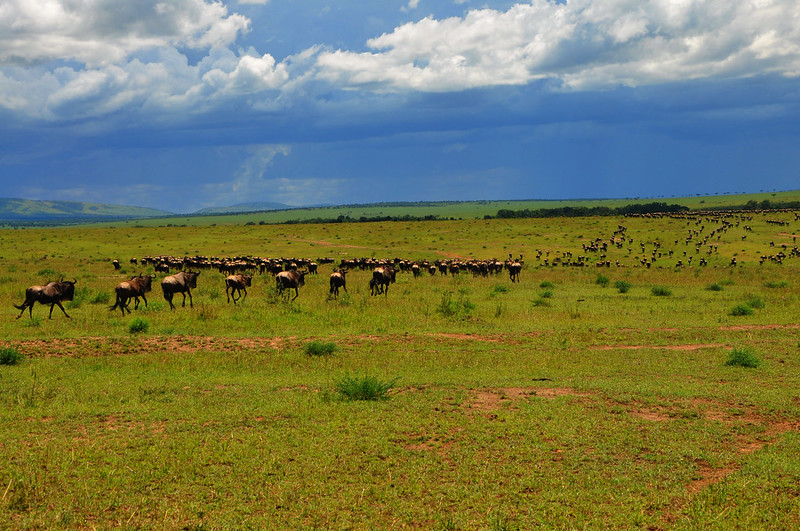
In most cases over 250,000 wildebeests die during the migration from Serengeti to Masai Mara, as they cover a large distance so some end up losing their lives due to exhaustion, hunger, thirst, also others are eaten by predators.
Zebras and other antelopes
It is estimated that there are 250,000 Burchell’s zebras in addition to about 300,000 various types of antelopes among which are the Thomson’s gazelles, impalas, Grant’s gazelles and elands that take part in this migration.
Predators
The great migrating herd offers plenty of prey for the different predators living within the areas that this herd matches through among which are big cats like lions, leopards and cheetahs; hyenas and crocodiles targeting the river crossings.
The wildebeest migration is one of the most amazing events one should never miss out, nothing is thrilling like watching the these animals in big numbers running up and down in the grasslands and crossing rivers, it gives an unforgettable experience in the wild.
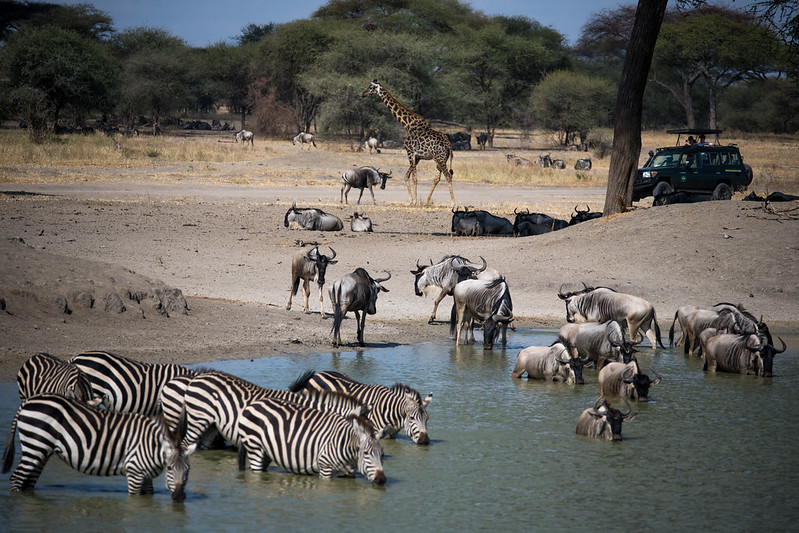
WHEN AND WHERE TO BEST OBSERVE THE MIGRATION
January-February-March (The Calving Season)
During this time many herds of wildebeests and zebras are around the Ngorongoro Conservation Area and in the Southern plains of the Serengeti, the grass there is short and rich, so most pregnant wildebeest find there stay here. The calving season starts at the end of January to mid March; around 600,000 calves are born in this time. Them being born in large numbers it is easier to survive predators than those born few and earlier.
During this time from January to March, these wildebeest migration can be viewed comfortably at a mobile camp, though most mobile camps are faced with the issue of flies so clients who are in for camping are advised to go in for Lake Masek Tented camp, then also midrange travelers can opt for Ndutu lodge as they observe the migration. Those who are into the luxury basis can go for Mwiba lodge, which is located a few kilometers away from Ndutu area so private vehicles can be offered by the lodge to take you to the area to observe the migration.

April-May
By the end of March to early May, this is considered an off season for observing wildebeests and other animals at large because there are heavy rains in Tanzania by this time. The grass during this time grows so tall and also roads become hard to pass through since the soils are slippery.
At the start of May the grass is already reduced since the population of the animals is a lot, so they choose to migrate looking for more grass. Most of the wildebeests and zebras move to the North via Seronera and the West near Lake Victoria and Serengeti’s western corridor, by this time these areas have enough water and longer grass.
In April, there is a possibility of observing the migration and the better place to stay would be Kusini Camp but there are many tsetse flies so the other option would be Ndutu Safari lodge. Other facilities include; Serengeti Kati Kati camp, Osupuko tented camp, Serengeti Serena safari lodge, Serengeti wildlife lodge
We generally don’t advise you to travel during April and May.
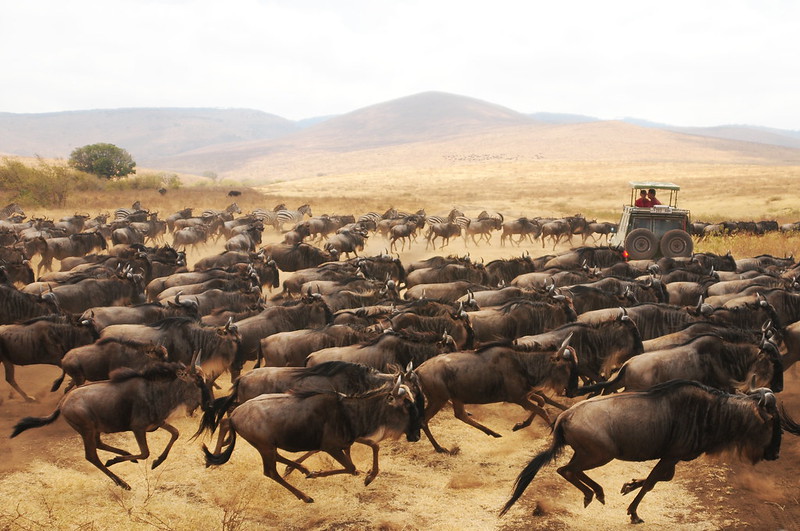
June
Early June the wildebeests start to move westwards because there is no enough food where they were. They tend to move to River Grumeti, which is surrounded by a forest and in this forest there are lots of elephants, buffaloes and in the river are a number of hippos and big-starving crocodiles that are ready to eat the wildebeests that come to drink water from the river.
There are different places where one can stay and catch the migration. They range from luxurious lodges such as Sasakwa Hill Lodge, Faru Faru River Lodge and Sabora Plains Tented camp; while here you not only watch the migration but also can have drives off the road, wildlife viewing walks and night drives. Other accommodation facilities where to see the migration include; Kirarwa and Grumeti River camp but while here you cannot do night drives or off road drives.
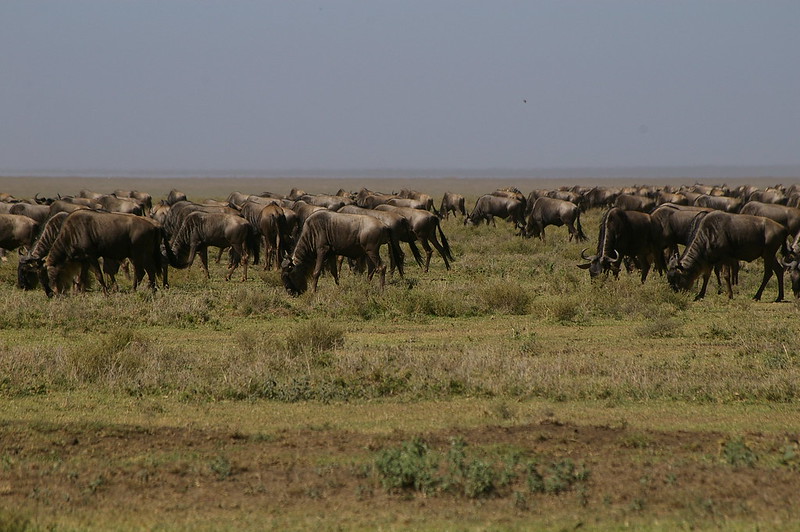
July-August-September-October
By this time, the water and grass has totally reduced in Grumeti and in the Western Corridor so wildebeests start moving to look for more grassland. So there are chances of watching migration around the Singita Grumeti reserve in July but these chances reduce as the month ends.
At the end of July to mid October, the herds of wildebeests divide themselves into smaller groups residing in the North of Serengeti and in the Masai Mara, during this time if it’s a dry season the wildebeests gather around water bodies particular the Masai River, whereby this river also has hungry crocodiles ready to prey on those that come to drink water.
In mid to late October there are short rains; because of this the wildebeests start moving south of the Masai Mara in Kenya. So by this time the best place to view the migration is the Masai Mara though this reserve is smaller than the Serengeti. So while here, you will not only observe the migration but also you could visit the nearby Maasai communities that have been there for very many years.
During this period, you can observe the migration while staying at different lodges and Camps. Staying in northern Serengeti is advisable since most herds are there and also are in the Masai Mara. For those in need of a luxurious treat the Singita’s Mara River Tented Camp can work for you, another is Sayari camp which is a few minutes away from the wildebeest herds. Other accommodation facilities include; Nomad’s Lamai Camp, Lemala Kuria Hills, Olakira, Serian, Kimondo, and Governor’s Camp (found in the Mara) among others.
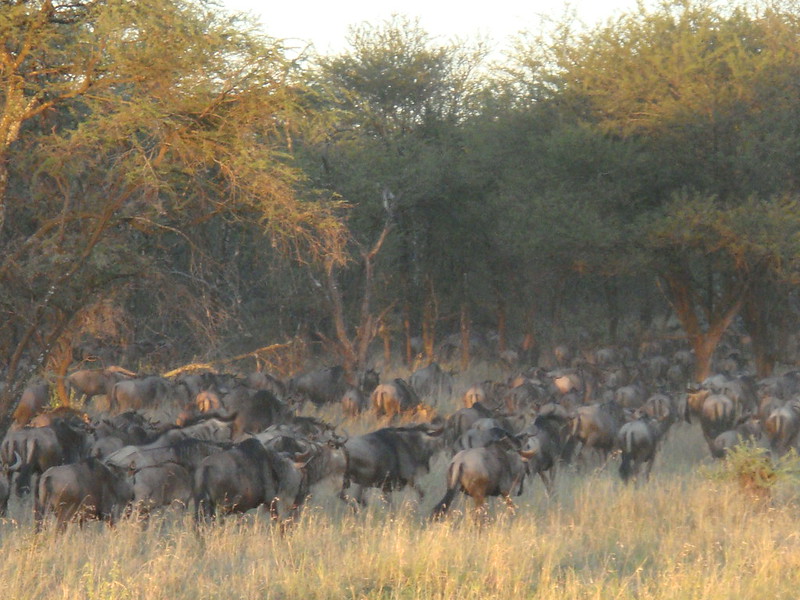
November-December
The rains continue throughout November so the wildebeests continue to move south and east. By December they start moving back to Southern Serengeti to the rich and short grasses. Most herds arrive by the end of December towards beginning of January which marks the end of that cycle.
Other areas in the Serengeti have tall grass growing at a fast rate hence making it difficult for wildlife viewing. So you are advised not to travel at this time of the year especially if you are interested in game safaris.
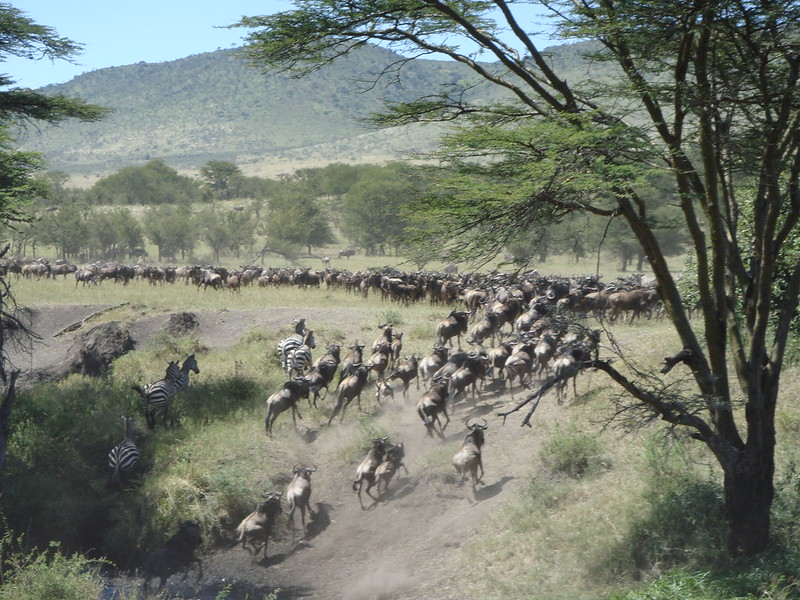
If you choose to travel during this time of the year, you can catch the migration while staying at Namiri Camp, staying in this area is an added advantage because it has different animals such as the cheetahs and lions. Nonetheless, it worth mentioning that because of these predators there are not many herds of wildebeests seen in this place. Also Klein’s camp could be better for viewing the migration but it has some tsetse flies.
After this cycle, the migration cycle begins again when the female wildebeests give birth to very many calves.
Choose to have a combined tour
The migration is an amazing and an unforgettable experience for every traveler but you could choose to add a standard safari to the viewing of the Great migration. This involves various activities such as night game drives in the Serengeti, cultural encounters by visiting the Maasai communities, Serengeti hot air balloon rides, visiting the beautiful coastal sand beaches near the ocean, and many more things. Plan your safari with us! I addition this safari can be combined with other popular safari destinations both in Kenya and Tanzania among which are: the Ngorongoro Crater, Lake Manyara National Park, Tarangire National Park and even climbing Mount Kilimanjaro
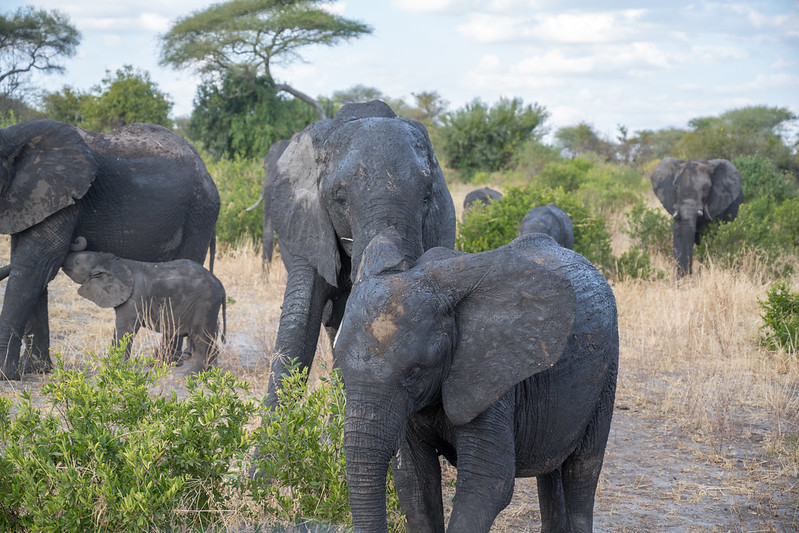
How To Get To Masai Mara National Reserve
It is easier when you arrange your safari with tour companies especially concerning the great migration since it could give you hard time to tell where to find the herds, where to stay, what you need and many more.
So how to get there will depend on whether you are to watch the migration in Serengeti or in the Masai Mara. Before beginning your travels make sure you have all that you need such as the immunization cards required, visas among other things. Make your safari bookings in advance through a trusted travel agent / company and just wait for that day! when Wtching the migration from the Masai Mara in Kenya, it will involve flying into Nairobi the capital of Kenya, and then taking a scheduled flight into the Mara Reserve, or you may take a road trip to the reserve.

Where to stay for The Great Wildebeest Migration in Tanzania
While on a Tanzania Safari to see the Great wildebeest Migration that includes close to 2 million animals the most recommended type of accommodation is staying in any of the Serengeti mobile camps. during the year, these mobile camps have particular locations (which may be 2 or 3) where they are pitched or set up depending on the movement and location of the migrating herd to offer guests the best views of these animals. The advantage of staying at the mobile camps is that you will get a chance to stay very close to the animals and follow the herd. Some of the most prominent mobile camps in the Serengeti are the &Beyond Serengeti Under Canvas and the Nomad Serengeti Safari Camp.
between July and November as well as from December to March, other mobile camps such as Kimondo Camp, Alex Walker’s Serian, Ubuntu migration camp and the Olakira Migration Camp also offer great accommodation however you should keep in mind that in the months of April, May and June these camps are normally closed so keep this in mind while booking your safari. Nonetheless, for the less adventurous travelers, you can choose to stay at any of the permanent lodges found in the Serengeti which will also give you a chance to see the great herd.
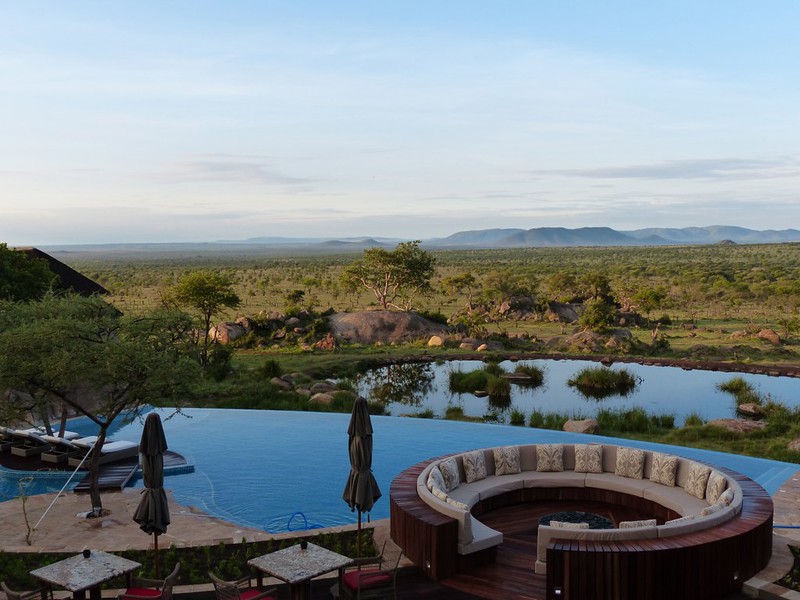
The Great Wildebeest Migration in Masai Mara – Kenya
The wildebeest migration is known by many to be one of the top Seven Wonders of the World as you will never get to see a huge number of animals moving in harmony with each other for a long time and distance. It is referred to as the world cup of wildlife and it happens between two countries that is Tanzania and Kenya. As they cross from the Serengeti National park in Tanzania, they head out to Masai Mara National Reserve found in Kenya after crossing the Mara River.
Masai Mara is also know for the high density of lions that it has and when the wildebeests cross to Masai Mara, they are hunted down by predators especially the big cats and this reduces the number of wildebeests that cross back to Serengeti.
The wildebeest migration takes place every year between two countries that is Tanzania and Kenya. There are approximately 1.5 million animals that cross from the Serengeti National Park to Masai Mara in Kenya and some of these include zebras which are estimated to be about 200,000, the Thomson Gazelles amounting to 350,000 and many more other hoofed animals. A million wildebeests can be witnessed during the great migration Most of these animals migrate in search of pastures and water and this migration has been termed as one of the best sceneries that one cannot afford to miss.

For us to get a clear picture of what the migration will be about, we are going to look at the birthing process and how the wildebeests come to life to start the long trek across the plains. The birthing process takes place between January and February with an estimate of over 300,000 to 400,000 calves born within a short interval of the other. The birthing of these calves mostly takes place on the slopes of the Ngorongoro crater mountain, the vast plains around Olduvai Gorge and Serengeti.
The birthing of the many calves bring about the prescience of the many predators like lions, leopards that mostly come out to hunt for the young ones who can hardly fend for themselves and they end up killing many especially those that don’t have the older animals protecting them. Much as many are killed during infancy, others grow and they become one of those that join in the great migration year after year.
These animals are believed to be moving towards a certain direction because they follow the weather and the March begins at the end of the month of March when the dry season starts in Serengeti National Park heading out to Masai Mara where the rains are abundant and the grass is enough for all the animals and these animals always stick together when they are traveling.
The animals walk miles and miles during this wildebeest migration and by visiting the two parks where the migration takes place, you get a clear view although you need to book early so that you get a clearer view since the place can be very crowded. During the migration you can also get to see other animals and bird species that are located in the area. The animals in the Serengeti national park can travel for more than 26000 square kilometers as they move from Serengeti to Masai Mara and then back to Serengeti.
Since the great wildebeest migration starts from Serengeti, we are going to be looking at the migration takes place and progresses month per month.
Arrival in Serengeti
The herds start arriving in Serengeti around November and December due to the start of the rains during this period. They settled around Ndutu area the North of Ngorongoro and the Seronera part which is south of Serengeti. The animals stay in this area through January to March and then spread throughout the Serengeti Park. Towards April, they start moving towards the Northern part of the park.
The animals start moving North in May while some of them move West wards in search of water and pasture. Tourists can easily see herds of animals in large columns moving to the Moru Kopjes and the North of Seronera.
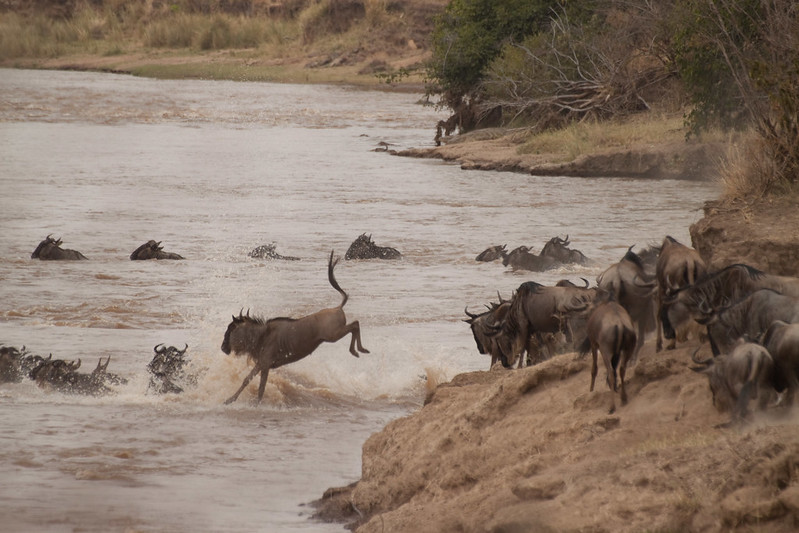
The rutting season
When the rains start, many of the herds are seen heading to koppies and Simba. Between May and June, this is known to be the rutting season and many of the animals are mated in this period and they can be seen in the Serengeti western corridor and the shores of Lake Victoria. When the animals leave the western corridor, they head out to the Masai Mara in Kenya. In June the herds can be seen moving to the Western corridor near the Grumeti River.
The herd congregates near the River for sometime in the south as they wait for others that were left behind. Once they are all in there, they cross the River in large numbers. The Grumeti River is famous for the numerous crocodiles that keep on feasting on the animals as they cross and the different channels that it has but still this does not stop the animals from crossing the Grumeti River and continue North wards.
The Wildebeest migration then continues to the North after crossing the Grumeti River in the months of July and August. During these months the herds separate as some of them head to the central part of Serengeti National Park while others head to Ikorongo and the Grumeti Reserve. While crossing the river, many animals lose their lives due to the predators that are found in the River and the wild currents.

The Mara River Crossing
In September, the herds cross over to the Northern part of the Serengeti National Park up to the Mara River. This is one of the hardest Rivers to cross and some animals can be seen struggling to cross the gushing Waters in the Mara River. This is a very spectacular view that you should not miss once you visit the Serengeti National park. And these animals can be seen crossing back to the south just after a few days.
Seemingly vicious fighting between dominant or territorial males takes place during the rut, though there is generally little actual violence or serious injury. And in spite of these energetic duels, the males have little say over their choice of mates, for it is the females who do the actual choosing.
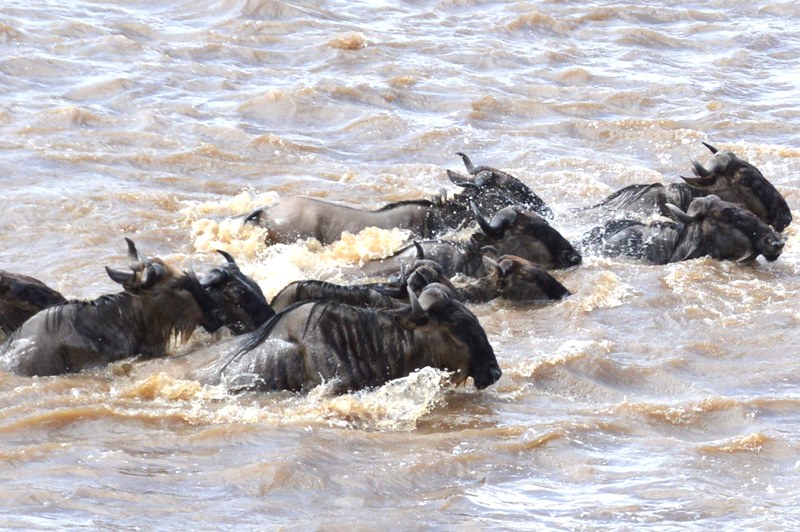
Arrival in Masai Mara National Reserve
From the western part of Serengeti, the herds head north to Masai Mara in Kenya. The Wildebeests cross the Mara River and Grumeti Rivers before they reach the Masai Mara Game Reserve. The rivers at times are easy to cross but there are times when they become violent and end up killing many wildebeests. The Rivers mostly the Grumeti has crocodiles which await the animals as they cross the River leading to the loss of many of the wildebeests.
The rivers have a lot of thick vegetation which may hide predators and yet the animals cannot change their course when it comes to trekking and therefore end up using the rivers even if they have the terror for water and predators. But despite all this, the crossing of these rivers is quite a sight that one cannot miss it.
When the animals reach the Mara River, they gather as they wait for the herds to increase and then cross at the same time. The crossing points for the animals differ every year and this may cause them to choose a suicidal place where hundreds of animals will drown.

Closing of the Migration Cycle
In October, the Wildebeest migrate to the south, move throughout the southern part of Loliondo to the Lobo area in the Serengeti Park before returning to Serengeti in November and then the great migration begins all over again.
The wildebeest migration is a repeated cycle by the different animals that trek and it is done every year. When planning a safari, this is one place that you should not miss. The animals move according to weather and they have the routes that they use in their instincts because it is hard to find when they have changed the routes.
Where to Stay During the Great Migration in Masai Mara – Kenya
Kenya is home to a great diversity of accommodations where holidaymakers can stay during this thrilling wildlife spectacle. These range from the luxury facilities, to mid-range facilities and then the budget facilities. Below are some of the most popular ones.
Royal Mara Safari Lodge is situated along the route used by the migrating herd of near two major areas where the animals cross the Mara River. It has eight (8) marvelously constructed suites.
The Kichwa Tembo Camp located in the middle of this Masai Mara Game Reserve is another amazing option and offers its guests forty (40) luxury tented camps. This is the best recommended place to stay especially for holidaymakers visiting the reserve for the first time.
Little Governor’s Camp is a remarkable camp offering seventeen (17) luxury tented camps with en-suite facilities pitched close to a big water-hole.
The Mara Serengeti Safari Lodge offers some of the best accommodation facilities within the Mara reserve as you enjoy views of the migration; it offers seventy four (74) beautiful rooms.
Cost of taking the Great Wildebeest Migration Safari
The matter of how much will it cost to see the great migration will depend on the number of days you plan to spend on your safari, which additional destinations you will be visiting as well as the type of accommodation you will use on your safari. See Tanzania safari cost in detail.
In the table below are estimated prices for two (2) people highlighting the number of days on safari, destinations visited and cost of safari.
Wildebeest Migration Safari Cost 2025
| Safari Duration | Safari Destinations | Accommodation Type | Safari Cost per person |
8 Day Migration Safari | Tarangire National Park, Serengeti National Park, Ngorongoro Conservation Area & Arusha National Park | Mid Range lodges | $2780 – $ 3,050 |
8-Day Camping Serengeti Migration | Lake Manyara National Park, Serengeti National Park, Ngorongoro Highlands & Crater, Tarangire NP, Arusha | Camping & budget Lodge | $2,050 – $2,150 |
7 Day Tanzania Migration Safari | southern Serengeti, Arusha & Serengeti National Park | Luxury tented camps | $3,820 – $5,150 |
6 Days Wildebeest Migration | Northern Serengeti, Central Serengeti, Ngorongoro Crater, Arusha | Mid Range Lodges | $ 4,150 – $4,750 |
5 Days Tanzania Migration Safari | Lake Manyara NP, Serengeti NP, Ngorongoro Highlands & Crater, Arusha | Luxury Lodges | $2,900 – $3,250 |
4 Days Kenya Migration Safari | Masai Mara National Park, annual migration | luxury | $1,050 – $1,550 |
4 Days Kenya Migration Safari | Masai Mara National Park | Mid-range | $950 – $1,190 |
The Botswana Wildebeest Migration
There is also another little known wildebeest migration but this involves Zebras mostly as they trek across the county in Botswana to the border of Namibia. This is recorded to be the wildebeest migration in Botswana, and it is known to be the longest wildlife terrestrial migration in Africa. The animals can be seen moving along the River systems from Chobe, Kwando Lenient and the Okavango to look for greener and comfortable wet weather conditions.
The migrations have been known to happen in Botswana till time memorial although the pattern has just been registered in 2012 and it was noted that these animals move through Botswana till the edge of Namibia. The migration in Botswana crosses over different National parks and this mainly consists of Zebras that are seen moving in the same direction in search of food and water. the animals march across the Nxai National park and the Makagdikgadi National park in Botswana. And these animals also follow the weather patterns that are dry and wet seasons as they traverse from one place to another looking for pastures and water from the water sources.

